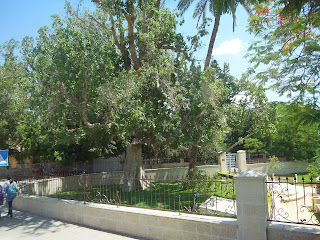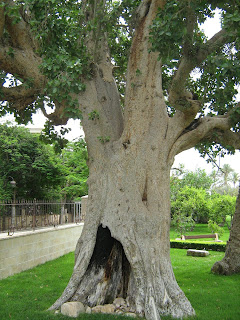Last year, I made plans to travel to New York in the middle of winter to
attend a 2 days retreat with Eugene Peterson. The fact that there will be
200 other pastor-leaders present did not deter me. It will be unlikely that
Eugene will have time to spend personally with me. What did deter me were
the comments of one of my friends. While not specifically referring to my
decision, he mentioned the word ‘celebrity-sighting.’
David Benner, a well known psychologist turned spiritual director will be
coming to Singapore next month. Should I sign up for the conference? I have
read most of his published works. Do I expect something new or is this just
another case of ‘celebrity sighting’.
Maybe Zacchaeus was also afflicted with a similar condition of ‘celebrity
sighting’. He must have heard of this miracle working itinerant Rabbi with a
large following. Maybe he just wanted a glimpse of this man. So knowing
Jericho, he chose a good vintage point – a sycamore tree. This is the tree
we were brought to see in Jericho. Now the poor tree must be the most
photographed tree in the world (if it is the correct tree!)


A large tree with heart-shaped leaves and edible
fruit sometimes called the “fig mulberry” (Ficus sycamorus L., not
any of the plane trees [Platanus] of North America that are called
“sycamores”). Sycamores were grown in generally frost-free lowland
areas (cf. Ps. 78:47). Sycamore cultivation in the Shephelah, for
which David’s government had a specific administrator (1 Chr.
27:28), became proverbial in its extent (1 Kgs. 10:27; 2 Chr. 1:15;
9:27). The “dresser” of sycamore trees (Amos 7:14) would pierce the
unripe fruit to cause it to sweeten and thus become more palatable.
Isa. 9:10 may refer to the use of sycamore wood in building. The
“sycamine tree” (JB, NIV “mulberry”) of Luke 17:6 is probably the
sycamore; its large size increases the impact of the saying (cf.
19:4). (Myers, A. C.1987. The Eerdmans Bible Dictionary.
Grand Rapids, Mich.: Eerdmans, 975).
 |
| photo from Anthony
Loke's FB |
Luke 19:1- 10
LK 19:1 Jesus
entered Jericho and was passing through.
2 A
man was there by the name of Zacchaeus; he was a chief tax collector and
was wealthy.
3 He
wanted to see who Jesus was, but being a short man he could not, because
of the crowd.
4 So
he ran ahead and climbed a sycamore-fig tree
to see him, since Jesus was coming that way.5 When
Jesus reached the spot, he looked up and said to him, "Zacchaeus, come
down immediately. I must stay at your house today."
6 So he came down at
once and welcomed him gladly.7 All
the people saw this and began to mutter, "He has gone to be the guest of
a `sinner.' "8 But
Zacchaeus stood up and said to the Lord, "Look, Lord! Here and now I
give half of my possessions to the poor, and if I have cheated anybody
out of anything, I will pay back four times the amount."9 Jesus
said to him, "Today salvation has come to this house, because this man,
too, is a son of Abraham.
10 For the Son of Man
came to seek and to save what was lost."
This narrative contains what may well be considered
the “key verse” of Luke—Luke 19:10. The incident contains several
primary Lukan features: the universal appeal of the gospel (vv. 2–4);
the ethical problem of wealth (v. 2); the call of a “sinner” who was in
social disfavor (v. 7); the sense of God’s present work (vv. 5, 9); the
feeling of urgency (“immediately,” speusas, v. 5), of necessity (“must,”
v. 5), and of joy (v. 6); restitution, With goods distributed to the
poor (v. 8); and, above all, salvation (vv. 9–10). (Leifeld, W. L. 1984.
Luke. In F. E. Gaebelein (Ed.), The Expositor's Bible Commentary,
Volume 8: Matthew, Mark, Luke (F. E. Gaebelein, Ed.). Grand Rapids,
MI: Zondervan Publishing House, 1007).
That Zacchareus did not fall off the tree when Jesus
addressed him directly is a tribute to his tree climbing ability.
Zacchareus is a Jew but one not well liked by his countrymen was obvious
from the fact that he had to climb the tree. He was wealthy. Wealthy men
often were and are able to go to the head of the crowd. Even his wealth
was not able to grant him a front row view. He was wealthy and also or
because he was the chief of tax collectors made him a despised person in
this community. Nobody liked Zacchareus except maybe his mother and his
Roman friends. It was curiosity that brought him up the tree.
When Jesus called him by name and invited himself to his house, it was
self-satisfaction that he came down and welcomed Jesus ‘gladly’
in front of his own people who despised him.
It was in his house, presumably over dinner that his
self-satisfaction turned to repentance. In fact he was so moved
that he pledged half his fortune to the poor and out of the other half,
he would pay back any one he had wronged fourfold (which is more than
the required amount). Money is one the most powerful of idols and the
hardest to destroy. Note that it is Jesus who took the initiative.
Jesus, who after healing the blind man (Luke 18: 35-43), walked into
Jericho, spied Zacchareus up in the tree, made the contact and evoked
the transformation. It was Jesus who delivered Zacchareus who was lost
in corruption and wealth as he has earlier delivered another man lost in
blindness and poverty. Jesus fulfils Ezekiel 34 when he brought
salvation into that household that day. This narrative is another
powerful reminder of our Lord Jesus who came with a mission of
redemption for the lost.
| 15 June 2012 |



